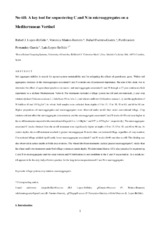No-till: a key tool for sequestering C and N in microaggregates on a Mediterranean Vertisol
Autor
López-Bellido Garrido, Rafael J.
Muñoz-Romero, Verónica
Fuentes-Guerra, Rafael
Fernández García, María Purificación
López Bellido, Luis
Editor
Science DirectFecha
2017Materia
Tillage systemCrop rotation
Macroaggregates
METS:
Mostrar el registro METSPREMIS:
Mostrar el registro PREMISMetadatos
Mostrar el registro completo del ítemResumen
Soil aggregate stability is crucial for agroecosystem sustainability and for mitigating the effects of greenhouse gases. Within soil aggregates, increases in the microaggregate-associated C and N contents are of paramount importance. The aim of this study was to determine the effect of agricultural practices on macro- and microaggregate-associated C and N through a 27-year continuous field experiment in a dryland Mediterranean Vertisol. The treatments included a tillage system (no-till and conventional), 2-year crop rotations [wheat (Triticum aestivum L.)-faba bean (Vicia faba L.) and wheat-sunflower (Helianthus annuus L.)], and the application of N fertilizer (0 and 100 kg ha−1) to wheat. Soil samples were collected from depths of 0 to 15, 15 to 30, 30 to 60, and 60 to 90 cm. Higher proportions of microaggregates and macroaggregates were observed under no-till than under conventional tillage. Crop rotations did not affect the microaggregate concentration, and the microaggregate-associated C and N stocks (0–90 cm) were higher in the no-till treatment compared with conventional tillage (6.9 vs. 4.4 Mg ha−1 and 957 vs. 672 kg ha−1, respectively). The microaggregate-associated C stocks obtained from the no-till treatment were significantly higher at depths of 0–15, 15–30, and 60–90 cm. At certain depths, the no-till treatment resulted in greater microaggregate N stocks than conventional tillage, regardless of crop rotation. Conventional tillage yielded significantly lower macroaggregate-associated C and N stocks (0–90 cm) than no-till. This finding was also observed at certain depths in both crop rotations. The wheat-faba bean treatments yielded greater macroaggregate C stocks than the wheat-sunflower treatments under both tillage systems at certain depths. We determined that no-till is a key practice for sequestering C and N in microaggregates and that crop rotation and N fertilization do not contribute to the C and N sequestration. As a result, no-till appears to be the only truly effective practice for the long-term encapsulation of C and N in microaggregates.

